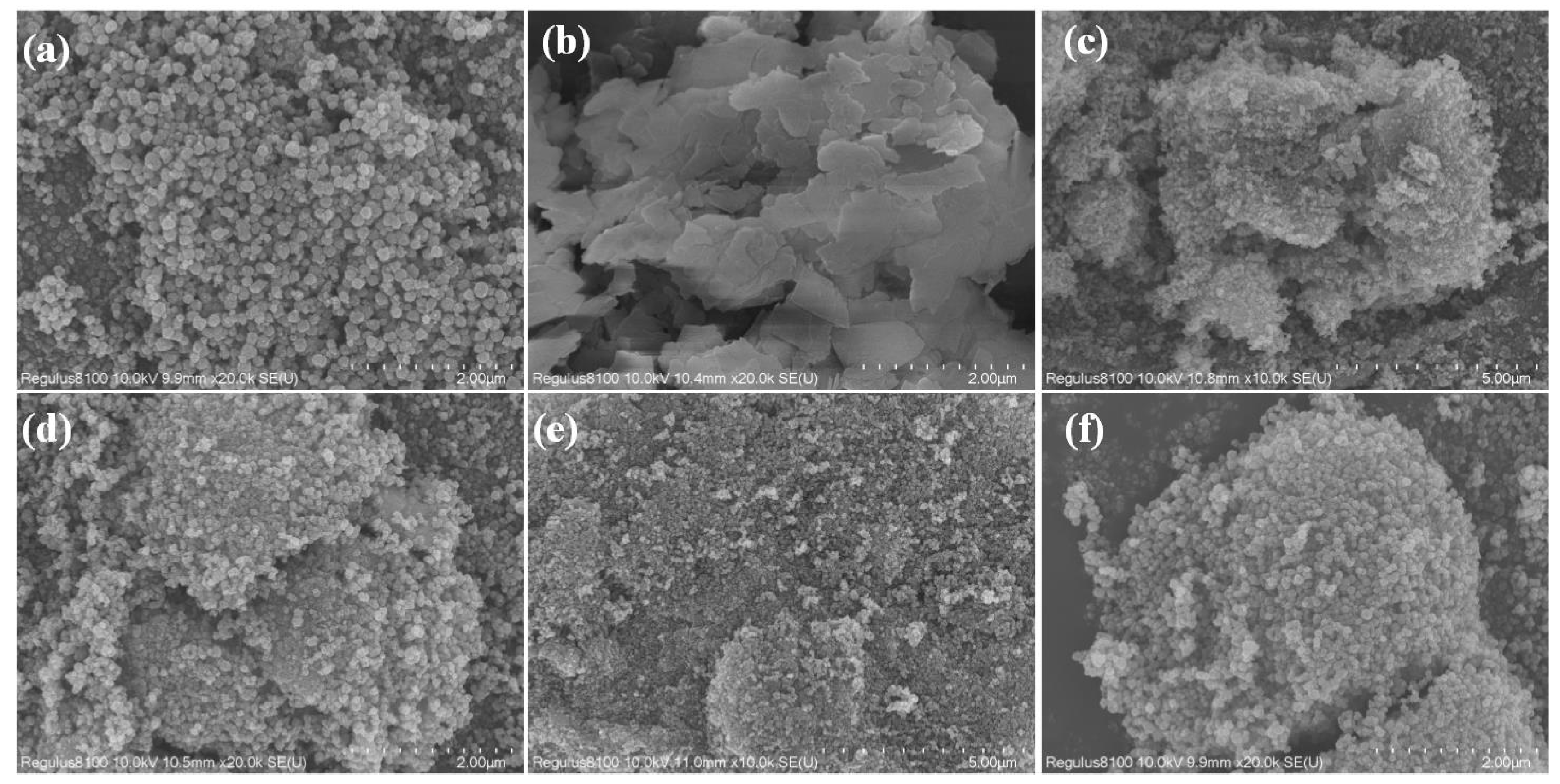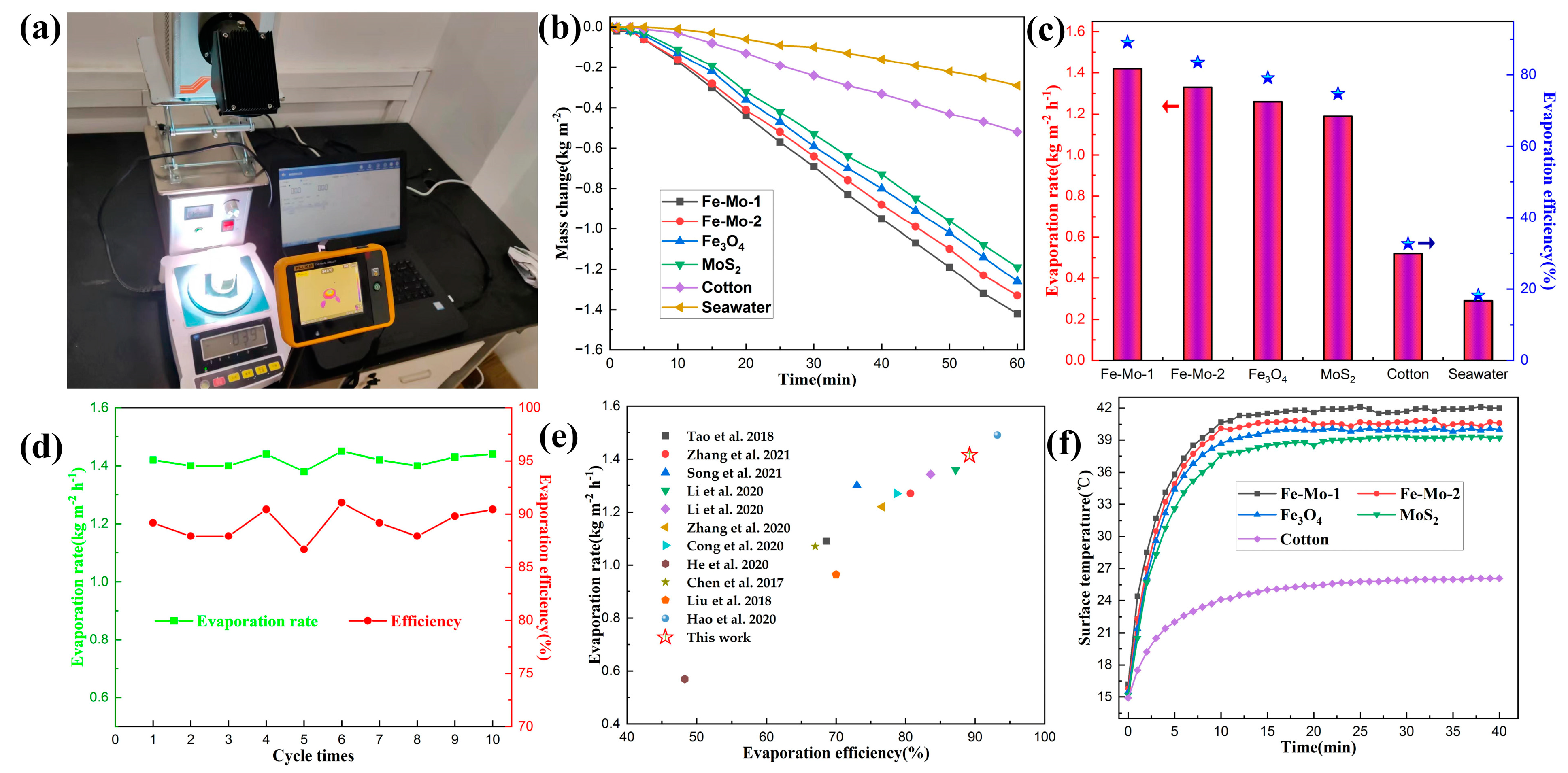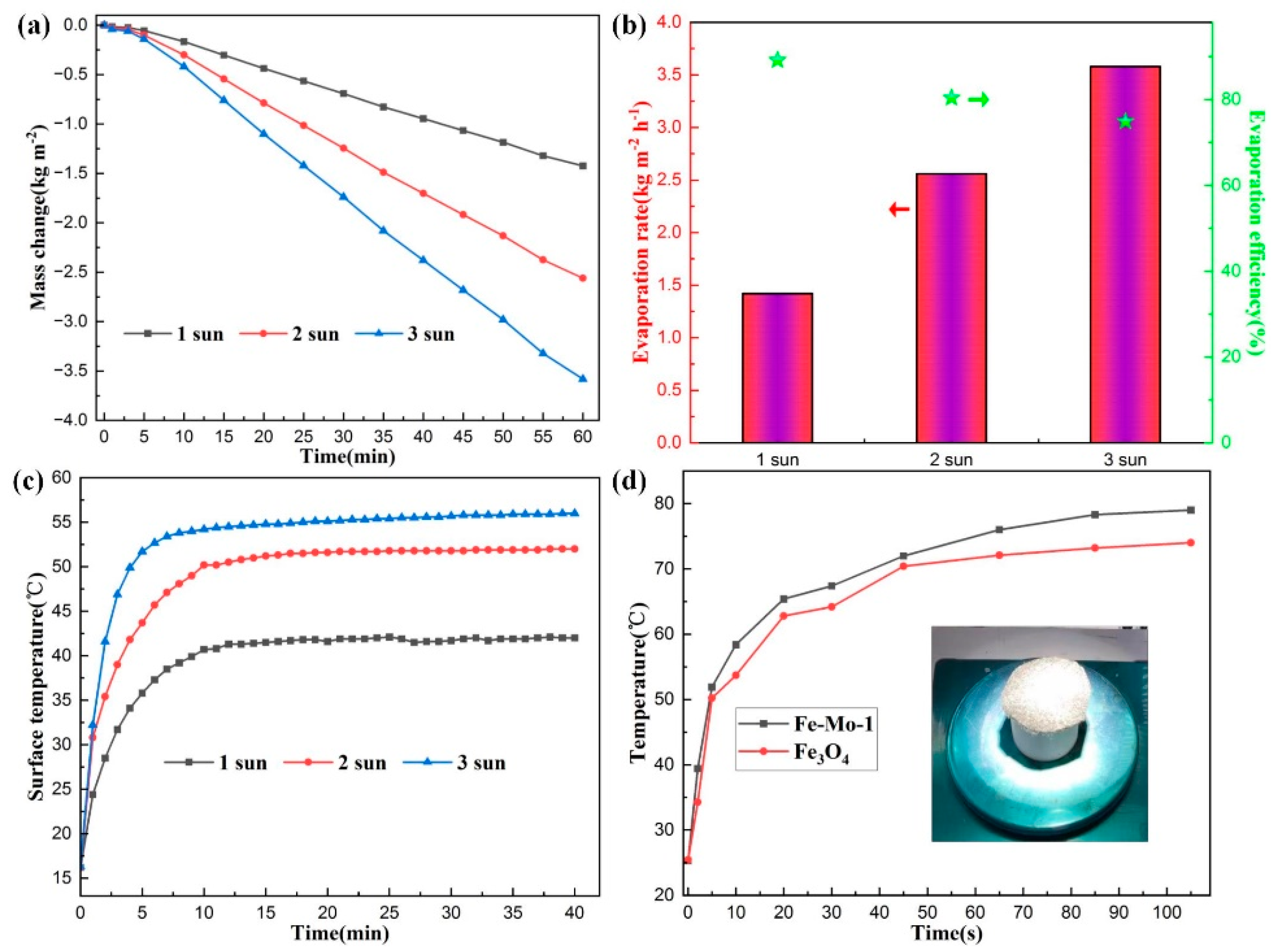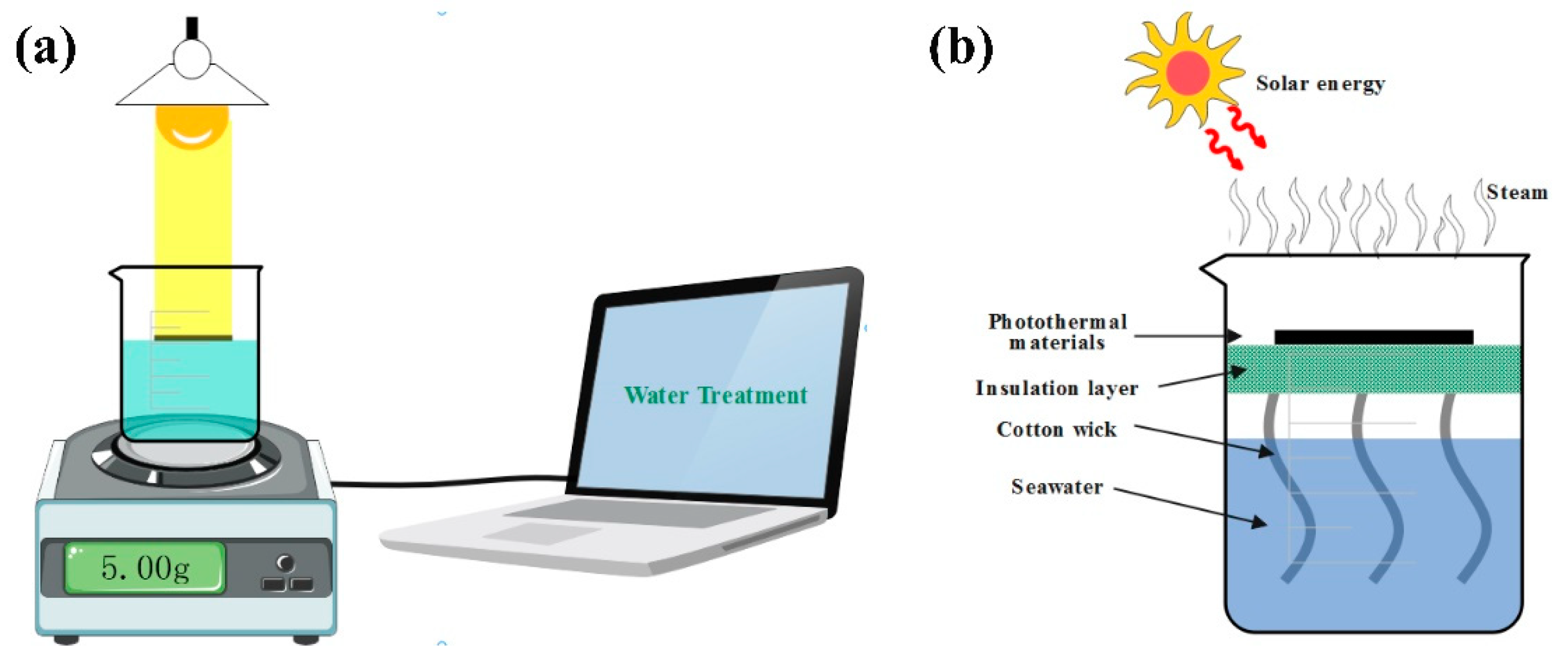MoS2 Nanosheets Decorated with Fe3O4 Nanoparticles for Highly Efficient Solar Steam Generation and Water Treatment
Abstract
:1. Introduction
2. Results and Discussion
2.1. Characterization of Samples
2.2. Photothermal Conversion Performance Test
2.3. Water Treatment Performance
3. Experimental Section
3.1. Materials
3.2. Preparation of Samples
3.2.1. Preparation of Fe3O4
3.2.2. Preparation of Fe3O4@MoS2
3.3. Characterization of Samples
3.4. SSG Experiment
3.5. SSG Test
3.6. SSG Water Treatment
4. Conclusions
Author Contributions
Funding
Acknowledgments
Conflicts of Interest
References
- Mehrkhah, R.; Goharshadi, E.K.; Ghafurian, M.M.; Mohammadi, M.; Mahian, O. Clean water production by non-noble metal/reduced graphene oxide nanocomposite coated on wood: Scalable interfacial solar steam generation and heavy metal sorption. Solar Energy 2021, 224, 440–454. [Google Scholar] [CrossRef]
- Wang, L.; Feng, Y.; Liu, Q.; Liu, G. Solar-thermo-radiative evaporator for continuous steam generation and salt harvesting. Solar Energy 2023, 250, 347–354. [Google Scholar] [CrossRef]
- Yang, T.; Lin, H.; Lin, K.-T.; Mesa Saldarriaga, D.; Yang, G.; Guo, C.; Zhang, H.; Zhang, J.; Fraser, S.; Lau, A.K.-T.; et al. Single-shot production of Janus graphene thin film for solar steam generation with 94.5% efficiency. Carbon 2022, 199, 469–478. [Google Scholar] [CrossRef]
- Ibrahim, I.; Seo, D.H.; McDonagh, A.M.; Shon, H.K.; Tijing, L. Semiconductor photothermal materials enabling efficient solar steam generation toward desalination and wastewater treatment. Desalination 2021, 500, 114853. [Google Scholar] [CrossRef]
- Lim, H.W.; Park, S.H.; Lee, S.J. 3D thermoresponsive hydrogel with enhanced water uptake and active evaporation for effective interfacial solar steam generation. Desalination 2023, 550, 116368. [Google Scholar] [CrossRef]
- Gao, C.; Zhu, J.; Li, J.; Zhou, B.; Liu, X.; Chen, Y.; Zhang, Z.; Guo, J. Honeycomb-structured fabric with enhanced photothermal management and site-specific salt crystallization enables sustainable solar steam generation. J. Colloid Interface Sci. 2022, 619, 322–330. [Google Scholar] [CrossRef]
- Ai, L.; Xu, Y.; Qin, S.; Luo, Y.; Wei, W.; Wang, X.; Jiang, J. Facile fabrication of Ni5P4-NiMoOx nanorod arrays with synergistic thermal management for efficient interfacial solar steam generation and water purification. J. Colloid Interface Sci. 2023, 634, 22–31. [Google Scholar] [CrossRef]
- Tao, F.; Zhang, Y.; Cao, S.; Yin, K.; Chang, X.; Lei, Y.; Fan, R.; Dong, L.; Yin, Y.; Chen, X. CuS nanoflowers/semipermeable collodion membrane composite for high-efficiency solar vapor generation. Mater. Today Energy 2018, 9, 285–294. [Google Scholar] [CrossRef]
- Kim, C.; Ryu, Y.; Shin, D.; Urbas, A.M.; Kim, K. Efficient solar steam generation by using metal-versatile hierarchical nanostructures for nickel and gold with aerogel insulator. Appl. Surf. Sci. 2020, 517, 146177. [Google Scholar] [CrossRef]
- He, M.; Alam, M.K.; Liu, H.; Zheng, M.; Zhao, J.; Wang, L.; Liu, L.; Qin, X.; Yu, J. Textile waste derived cellulose based composite aerogel for efficient solar steam generation. Compos. Commun. 2021, 28, 100936. [Google Scholar] [CrossRef]
- Li, L.; Hu, T.; Li, A.; Zhang, J. Electrically Conductive Carbon Aerogels with High Salt-Resistance for Efficient Solar-Driven Interfacial Evaporation. ACS Appl. Mater. Interfaces 2020, 12, 32143–32153. [Google Scholar] [CrossRef] [PubMed]
- Zhang, L.; Bai, B.; Hu, N.; Wang, H. Low-cost and facile fabrication of a candle soot/adsorbent cotton 3D-interfacial solar steam generation for effective water evaporation. Sol. Energy Mater. Sol. Cells 2021, 221, 110876. [Google Scholar] [CrossRef]
- Zhang, L.; Mu, L.; Zhou, Q.; Hu, X. Solar-assisted fabrication of dimpled 2H-MoS2 membrane for highly efficient water desalination. Water Res. 2020, 170, 115367. [Google Scholar] [CrossRef] [PubMed]
- Wang, Q.; Jia, F.; Huang, A.; Qin, Y.; Song, S.; Li, Y.; Arroyo, M.A.C. MoS2@sponge with double layer structure for high-efficiency solar desalination. Desalination 2020, 481, 114359. [Google Scholar] [CrossRef]
- Wang, Q.; Qin, Y.; Jia, F.; Li, Y.; Song, S. Magnetic MoS2 nanosheets as recyclable solar-absorbers for high-performance solar steam generation. Renew. Energy 2021, 163, 146–153. [Google Scholar] [CrossRef]
- Zhang, L.; Liu, G.; Wu, L.; Chen, Z.; Dai, Z.; Yu, F.; Wang, X. Integrated light adsorption and thermal insulation of Zn doping 1T phase MoS2-based evaporation prototype for continuous freshwater generation. Chem. Eng. J. 2023, 454, 140298. [Google Scholar] [CrossRef]
- Shin, Y.; Ham, J.; Boldoo, T.; Cho, H. Magnetic effect on the enhancement of photo-thermal energy conversion efficiency of MWCNT/Fe3O4 hybrid nanofluid. Sol. Energy Mater. Sol. Cells 2020, 215, 110635. [Google Scholar] [CrossRef]
- Shi, L.; He, Y.; Huang, Y.; Jiang, B. Recyclable Fe3O4@CNT nanoparticles for high-efficiency solar vapor generation. Energy Convers. Manag. 2017, 149, 401–408. [Google Scholar] [CrossRef]
- Song, L.; Zhang, X.-F.; Wang, Z.; Zheng, T.; Yao, J. Fe3O4/polyvinyl alcohol decorated delignified wood evaporator for continuous solar steam generation. Desalination 2021, 507, 115024. [Google Scholar] [CrossRef]
- Xiao, J.; Guo, Y.; Luo, W.; Wang, D.; Zhong, S.; Yue, Y.; Han, C.; Lv, R.; Feng, J.; Wang, J.; et al. A scalable, cost-effective and salt-rejecting MoS2/SA@melamine foam for continuous solar steam generation. Nano Energy 2021, 87, 106213. [Google Scholar] [CrossRef]
- Xu, R.; Cui, H.; Sun, K.; Song, X.; Yang, K.; Wei, N.; Hou, C.; Zhao, M. Controllable 3D interconnected featured pore structure of transition metal borides-carbonitride/MoS2 for efficiently solar evaporation and wastewater purification. Chem. Eng. J. 2022, 446, 137275. [Google Scholar] [CrossRef]
- Xu, R.; Wei, N.; Li, Z.; Song, X.; Li, Q.; Sun, K.; Yang, E.; Gong, L.; Sui, Y.; Tian, J.; et al. Construction of hierarchical 2D/2D Ti3C2/MoS2 nanocomposites for high-efficiency solar steam generation. J. Colloid Interface Sci. 2021, 584, 125–133. [Google Scholar] [CrossRef]
- Guo, Q.; Yi, H.; Jia, F.; Song, S. Design of MoS2/MMT bi-layered aerogels integrated with phase change materials for sustained and efficient solar desalination. Desalination 2022, 541, 116028. [Google Scholar] [CrossRef]
- Li, W.; Chen, Y.; Yao, L.; Ren, X.; Li, Y.; Deng, L. Fe3O4/PVDF-HFP photothermal membrane with in-situ heating for sustainable, stable and efficient pilot-scale solar-driven membrane distillation. Desalination 2020, 478, 114288. [Google Scholar] [CrossRef]
- Garousi, E.; Hossaini Sadr, M.; Rashidi, A.; Yousefi, M. MoS2 QDs-nanoparticle-engineered based hydrophobic filter for high performance water-oil separation. Inorg. Chem. Commun. 2022, 138, 109223. [Google Scholar] [CrossRef]
- Bai, Z.; Xu, H.; Yang, B.; Yao, J.; Li, G.; Guo, K.; Wang, N.; Liang, N. Fe3O4/Diatomite-Decorated Cotton Evaporator for Continuous Solar Steam Generation and Water Treatment. Materials 2022, 15, 6110. [Google Scholar] [CrossRef]
- Li, D.; Li, A.; Chen, Y.; Chen, G.; Chen, X.; Zhang, D.; Zhu, H.; Samo, I.A.; Song, H. Spray-freezing induced multidimensional morphology tuning of assembled spherical carbon for solar-driven steam generation. Carbon 2020, 162, 481–489. [Google Scholar] [CrossRef]
- Zhang, C.; Xiao, P.; Ni, F.; Yan, L.; Liu, Q.; Zhang, D.; Gu, J.; Wang, W.; Chen, T. Converting Pomelo Peel into Eco-friendly and Low-Consumption Photothermic Biomass Sponge toward Multifunctioal Solar-to-Heat Conversion. ACS Sustain. Chem. Eng. 2020, 8, 5328–5337. [Google Scholar] [CrossRef]
- Cong, C.; Gao, M.; Xing, G.; Wu, Y.; Liu, L.; Mainul, M.; Wang, J.; Wang, Z. Carbon nanomaterials treated by combination of oxidation and flash for highly efficient solar water evaporation. Chemosphere 2021, 277, 130248. [Google Scholar] [CrossRef] [PubMed]
- He, J.; Foysal, T.R.; Yang, H.; Islam, M.; Li, L.; Li, W.; Cui, W. A facile and low-cost method to improve the efficiency of solar steam evaporation. Mater. Lett. 2020, 261, 126962. [Google Scholar] [CrossRef]
- Chen, R.; Zhu, K.; Gan, Q.; Yu, Y.; Zhang, T.; Liu, X.; Ye, M.; Yin, Y. Interfacial solar heating by self-assembled Fe3O4@C film for steam generation. Mater. Chem. Front. 2017, 1, 2620–2626. [Google Scholar] [CrossRef]
- Liu, S.; Huang, C.; Luo, X.; Rao, Z. High-performance solar steam generation of a paper-based carbon particle system. Appl. Therm. Eng. 2018, 142, 566–572. [Google Scholar] [CrossRef]
- Hao, L.; Liu, N.; Zhang, B.; Niu, R.; Gong, J.; Tang, T. Waste-to-wealth: Sustainable conversion of polyester waste into porous carbons as efficient solar steam generators. J. Taiwan Inst. Chem. Eng. 2020, 115, 71–78. [Google Scholar] [CrossRef]
- Wu, X.; Wu, L.; Tan, J.; Chen, G.Y.; Owens, G.; Xu, H. Evaporation above a bulk water surface using an oil lamp inspired highly efficient solar-steam generation strategy. J. Mater. Chem. A 2018, 6, 12267–12274. [Google Scholar] [CrossRef]
- Li, Q.; Zhang, S.; Wei, N.; Xu, R.; Li, X.; Gong, L.; Cui, H. Porous Ni/CNTs composite membrane as solar absorber for highly efficient solar steam generation. Sol. Energy Mater. Sol. Cells 2022, 243, 111815. [Google Scholar] [CrossRef]
- Zhang, Z.; Fang, Y.; Zhuo, L.; Yuan, H.; Zhang, L. Reduced graphene oxide wrapped Fe3O4@TiO2 yolk–shell nanostructures as a magnetic recyclable photocatalytic antibacterial agent. J. Alloy. Compd. 2022, 904, 164001. [Google Scholar] [CrossRef]
- Chen, Y.; Fang, J.; Ling, T.; Xia, M.; Xu, P.; Cao, Y.; Wei, D.; Gao, J. Bamboo shoot-based evaporator with self-cleaning and mildew-resistant for efficient solar steam generation. Desalination 2022, 541, 116003. [Google Scholar] [CrossRef]
- Bai, L.; Zhang, H.; Lou, R.; Li, J.; Chi, M.; Sha, J.; Zhou, X. A biomass-based bilayer aerogel for efficient solar-driven steam production and electricity generation. Chem. Eng. J. 2023, 455, 140934. [Google Scholar] [CrossRef]
- Wu, X.; Gao, T.; Han, C.; Xu, J.; Owens, G.; Xu, H. A photothermal reservoir for highly efficient solar steam generation without bulk water. Sci. Bull. 2019, 64, 1625–1633. [Google Scholar] [CrossRef]
- Yang, M.; Chu, T.; Shi, J.; Zhang, J.; Zhang, Y.; Wang, L. Synergy of photothermal effect in integrated 0D natural melanin/2D reduced graphene oxide for effective solar steam generation and water purification. Colloids Surf. A Physicochem. Eng. Asp. 2022, 632, 127786. [Google Scholar] [CrossRef]
- Wang, J.; Guo, Z.; Xiao, B.; Xiong, X.; Liu, G.; Wang, X. Reduced graphene oxide/Cu7·2S4 composite hydrogels for highly efficient solar steam generation. Mater. Today Sustain. 2022, 18, 100121. [Google Scholar] [CrossRef]
- Ahmad Wani, T.; Garg, P.; Bera, S.; Bhattacharya, S.; Dutta, S.; Kumar, H.; Bera, A. Narrow-Bandgap LaMO3 (M = Ni, Co) nanomaterials for efficient interfacial solar steam generation. J. Colloid Interface Sci. 2022, 612, 203–212. [Google Scholar] [CrossRef] [PubMed]
- Zhao, F.; Zhou, X.; Shi, Y.; Qian, X.; Alexander, M.; Zhao, X.; Mendez, S.; Yang, R.; Qu, L.; Yu, G. Highly efficient solar vapour generation via hierarchically nanostructured gels. Nat. Nanotechnol. 2018, 13, 489–495. [Google Scholar] [CrossRef] [PubMed]
- Yao, J.; Zhang, K.; Wang, W.; Zuo, X.; Yang, Q.; Wu, M.; Li, G. Great enhancement of electrochemical cyclic voltammetry stabilization of Fe3O4 microspheres by introducing 3DRGO. Electrochim. Acta 2018, 279, 168–176. [Google Scholar] [CrossRef]
- Li, Y.; Zhang, S.; Xia, Z.; Wang, L.; Fan, J. Micro-macro-capillaries fabric-based evaporator for eliminating salt accumulation and highly efficient solar steam generation. Sep. Purif. Technol. 2023, 308, 122852. [Google Scholar] [CrossRef]
- Ibrahim, I.; Seo, D.H.; Angeloski, A.; McDonagh, A.; Shon, H.K.; Tijing, L.D. 3D microflowers CuS/Sn2S3 heterostructure for highly efficient solar steam generation and water purification. Sol. Energy Mater. Sol. Cells 2021, 232, 111377. [Google Scholar] [CrossRef]
- Zhang, X.; Pi, M.; Lu, H.; Li, M.; Wang, X.; Wang, Z.; Ran, R. A biomass hybrid hydrogel with hierarchical porous structure for efficient solar steam generation. Sol. Energy Mater. Sol. Cells 2022, 242, 111742. [Google Scholar] [CrossRef]
- Feng, J.; Bai, B.; Yang, L.; Hu, N.; Wang, H. Low-cost and facile hydrophilic amplification of raw corn straws for the applications of highly efficient interfacial solar steam generation. Mater. Chem. Phys. 2021, 271, 124904. [Google Scholar] [CrossRef]










| Ion Type | Ca2+ | K+ | Mg2+ | Na+ |
|---|---|---|---|---|
| Ion concentration before desalination (mg/L) | 286 | 380 | 990 | 9000 |
| Ion concentration after desalination (mg/L) | 0.38 | 0.68 | 0.05 | 8.37 |
| Ion Type | Cu2+ | Ni+ | Zn2+ | Co2+ |
|---|---|---|---|---|
| Ion concentration before purification (mg/L) | 128 | 14.5 | 147 | 60 |
| Ion concentration after purification (mg/L) | 0.1 | 0.05 | 0.22 | 0.02 |
Disclaimer/Publisher’s Note: The statements, opinions and data contained in all publications are solely those of the individual author(s) and contributor(s) and not of MDPI and/or the editor(s). MDPI and/or the editor(s) disclaim responsibility for any injury to people or property resulting from any ideas, methods, instructions or products referred to in the content. |
© 2023 by the authors. Licensee MDPI, Basel, Switzerland. This article is an open access article distributed under the terms and conditions of the Creative Commons Attribution (CC BY) license (https://creativecommons.org/licenses/by/4.0/).
Share and Cite
Bai, Z.; Xu, H.; Li, G.; Yang, B.; Yao, J.; Guo, K.; Wang, N. MoS2 Nanosheets Decorated with Fe3O4 Nanoparticles for Highly Efficient Solar Steam Generation and Water Treatment. Molecules 2023, 28, 1719. https://doi.org/10.3390/molecules28041719
Bai Z, Xu H, Li G, Yang B, Yao J, Guo K, Wang N. MoS2 Nanosheets Decorated with Fe3O4 Nanoparticles for Highly Efficient Solar Steam Generation and Water Treatment. Molecules. 2023; 28(4):1719. https://doi.org/10.3390/molecules28041719
Chicago/Turabian StyleBai, Zhi, Haifeng Xu, Guang Li, Bo Yang, Jixin Yao, Kai Guo, and Nan Wang. 2023. "MoS2 Nanosheets Decorated with Fe3O4 Nanoparticles for Highly Efficient Solar Steam Generation and Water Treatment" Molecules 28, no. 4: 1719. https://doi.org/10.3390/molecules28041719
APA StyleBai, Z., Xu, H., Li, G., Yang, B., Yao, J., Guo, K., & Wang, N. (2023). MoS2 Nanosheets Decorated with Fe3O4 Nanoparticles for Highly Efficient Solar Steam Generation and Water Treatment. Molecules, 28(4), 1719. https://doi.org/10.3390/molecules28041719





